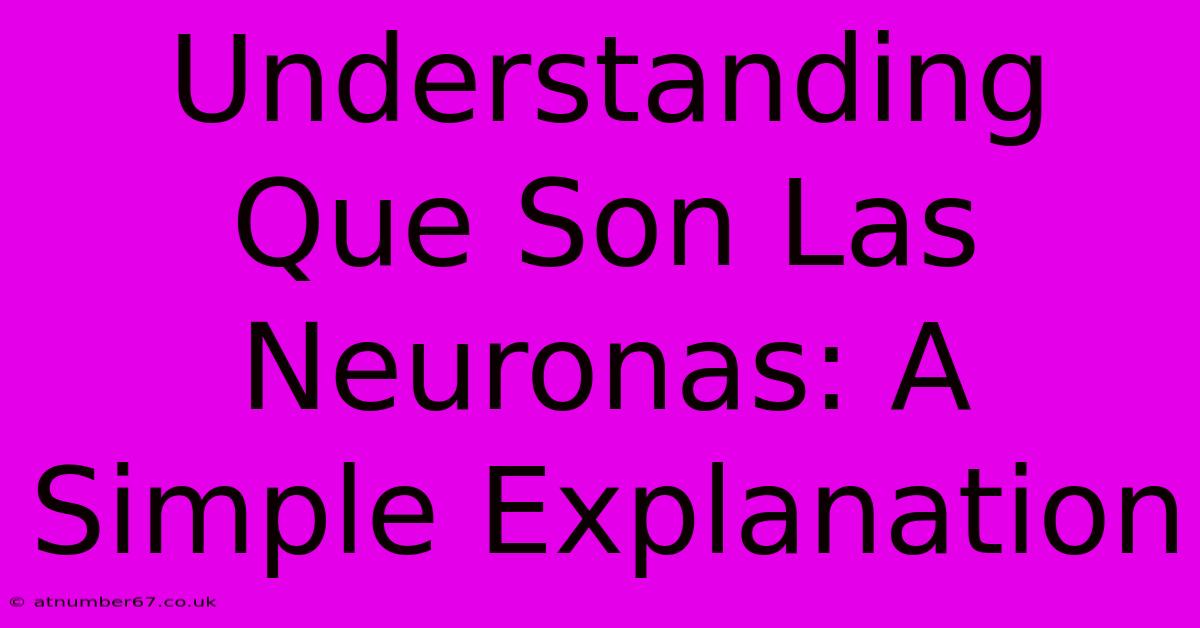Understanding Que Son Las Neuronas: A Simple Explanation

Table of Contents
Understanding Qué Son Las Neuronas: A Simple Explanation
Understanding how the brain works is a fascinating journey, and at the heart of it all are neurons. This article will provide a simple explanation of qué son las neuronas, or what neurons are, in Spanish and English, for a broader audience. We'll explore their structure, function, and their vital role in everything we think, feel, and do.
What are Neurons? (¿Qué son las neuronas?)
Neurons, also known as nerve cells, are the fundamental units of the nervous system. They are specialized cells that transmit information throughout the body via electrochemical signals. Think of them as the tiny messengers that allow your brain to communicate with the rest of your body and vice-versa. Las neuronas son las unidades básicas del sistema nervioso, responsible for everything from simple reflexes to complex thought processes.
The Structure of a Neuron (La Estructura de una Neurona)
Each neuron has three main parts:
- Soma (Cuerpo Celular): This is the neuron's cell body, containing the nucleus and other essential organelles. It's the control center of the neuron.
- Dendrites (Dendritas): These are branching extensions that receive signals from other neurons. Think of them as the neuron's "ears," listening for incoming messages.
- Axon (Axón): This is a long, slender projection that transmits signals away from the soma to other neurons or muscles. It's the neuron's "mouth," sending out messages. The axon is often covered in a protective layer called the myelin sheath, which speeds up signal transmission.
How Neurons Communicate (Cómo se Comunican las Neuronas)
Neurons communicate with each other through a process called synaptic transmission. When a neuron receives a signal, it triggers an electrical impulse that travels down its axon. This impulse reaches the end of the axon, called the axon terminal. At the axon terminal, the signal is converted into a chemical message, called a neurotransmitter.
The neurotransmitter is released into the synapse, a tiny gap between the axon terminal of one neuron and the dendrite of another. The neurotransmitter then binds to receptors on the receiving neuron, triggering a new electrical impulse in that neuron. This process allows information to be passed from one neuron to the next, creating complex neural networks.
Types of Neurons (Tipos de Neuronas)
There are many types of neurons, each with specialized functions. Some of the most common types include:
- Sensory neurons: These neurons transmit signals from sensory receptors (like those in your eyes and ears) to the central nervous system.
- Motor neurons: These neurons transmit signals from the central nervous system to muscles and glands, causing them to contract or secrete substances.
- Interneurons: These neurons connect sensory and motor neurons within the central nervous system.
The Importance of Neurons (La Importancia de las Neuronas)
Neurons are essential for virtually every aspect of our lives. They are responsible for:
- Movement: Controlling voluntary and involuntary muscle contractions.
- Sensation: Processing sensory information from the environment.
- Cognition: Enabling thought, memory, and learning.
- Emotion: Regulating our emotional responses.
Understanding qué son las neuronas is crucial for understanding how our brains and bodies function. Their intricate network of communication is the foundation of our entire being. Further research into neuroscience continues to unravel the complexities of these fascinating cells and their impact on human health and behavior.

Thank you for visiting our website wich cover about Understanding Que Son Las Neuronas: A Simple Explanation. We hope the information provided has been useful to you. Feel free to contact us if you have any questions or need further assistance. See you next time and dont miss to bookmark.
Featured Posts
-
Heart Evangelista S Net Worth A Multifaceted Success Story
Apr 06, 2025
-
From Zero To Millions Rokbloks Net Worth
Apr 06, 2025
-
The Verstappen Family A Dynasty In The Making
Apr 06, 2025
-
Wizkid Age Fact Vs Fiction
Apr 06, 2025
-
Louis Therouxs Son The Strength Of Family Bonds
Apr 06, 2025
